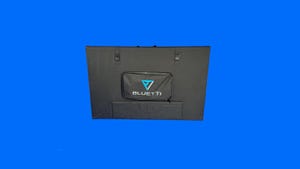
Best Portable Solar Panels for 2023 - CNET
Many people are turning to rooftop solar panels to meet their energy needs at home. But you can meet your mobile energy needs through solar, too. A growing number of companies now offer portable solar panels, in a wide range of sizes.
Thanks to its light weight and impressive capacity, we’ve chosen the Jackery SolarSaga 200 as our best portable solar panel overall, but there are solar panels for every situation.
Portable solar panels can charge devices anywhere the sun is shining. They can also be used to charge up portable power stations, which they’re often packaged with as solar generators — clean and quiet replacements to portable generators that don’t rely on gas.
Can solar panels save you money?
Interested in understanding the impact solar can have on your home? Enter some basic information below, and we’ll instantly provide a free estimate of your energy savings.
Before you buy a portable solar panel, define your needs and the most likely scenario in which you’ll use it. How much power will you actually need? How portable does it need to be? Will you be hiking with it? Throwing it in the back of your car? Using it just at home? How quickly do you need it to charge your devices or batteries?
Whether or not you’ve nailed down answers to those questions, take a look at our picks for the best portable solar panels. I’ve chosen what I think are the best options based on size, charging needs and application. Besides highlighting our favorites, I’ll let you know what other models I considered and how I came to my decision. That way, you can carefully consider which option is best for you.
Can solar panels save you money?
Interested in understanding the impact solar can have on your home? Enter some basic information below, and we’ll instantly provide a free estimate of your energy savings.
Best portable solar panels of 2023
<div data-id="" data-cy="shortcodeListicle" data-location="LIST" data-position="1" edition="us" superlative="Best overall portable solar panel" imagegroup="{"alt":"Jackery SolarSaga 200 solar panel.","caption":"
The Jackery SolarSaga 200 portable solar panel folds up neatly into an easy-to-carry package.
","credits":"Steve Conaway/CNET","imageData":{"id":"d264837b-654b-4b43-92b1-ba9f7e31fc4e","title":"solarpan-jackeryss200","filename":"solarpan-jackeryss200.jpg","path":"https://www.cnet.com/a/img/hub/2022/12/14/d264837b-654b-4b43-92b1-ba9f7e31fc4e/solarpan-jackeryss200.jpg","caption":"
The Jackery SolarSaga 200 portable solar panel folds up neatly into an easy-to-carry package.
","size":93155,"width":1600,"height":900,"dateCreated":{"date":"2022-12-14 22:16:58","timezone":"UTC","timezone_type":3},"dateUpdated":{"date":"2022-12-14 22:17:44","timezone":"UTC","timezone_type":3},"needsModeration":false,"mimeType":"image/jpeg","deleted":false,"credits":"Steve Conaway/CNET","alt":"Jackery SolarSaga 200 solar panel.","restricted":false,"startDate":null,"endDate":null,"preferred":false,"watermark":false,"doNotCrop":false,"doNotResize":false,"primaryCollection":null,"vanityUrl":null,"notes":null,"crop":null,"cropGravity":0,"preservedRegion":null,"isNew":false,"keywords":[],"primeColor":null,"hasWarning":false,"typeName":"content_image"},"uuid":"d264837b-654b-4b43-92b1-ba9f7e31fc4e","imageAltText":"Jackery SolarSaga 200 solar panel.","imageCaption":"
The Jackery SolarSaga 200 portable solar panel folds up neatly into an easy-to-carry package.
","imageCredit":"Steve Conaway/CNET","imageDoNotCrop":false,"imageDoNotResize":false,"imageWatermark":false,"imageFilename":"solarpan-jackeryss200.jpg","imageDateCreated":"2022/12/14","imageWidth":1600,"imageHeight":900,"imageParallax":"","imageCrop":"","imageEnlarge":false}” overridecaption=”
The Jackery SolarSaga 200 portable solar panel folds up neatly into an easy-to-carry package.
” overridecredit=”Steve Conaway/CNET” usepricing=”true” data-key=”cnetlisticle__3d54bf14-0cf9-4c9e-b837-8ec3924a3b80″ position=”NaN” contenttype=”Best List – Precap” pagelayout=”Default – Article Page” showdetails=”true” class=”c-shortcodeListicle g-border-thin-light-top g-inner-spacing-bottom-medium g-inner-spacing-left-large g-inner-spacing-right-large g-inner-spacing-bottom-xlarge g-outer-spacing-bottom-large g-border-thin-light-bottom g-border-thin-light-right g-border-thin-light-left”>
Jackery SolarSaga 200 (the largest of their SolarSaga series) is my top choice for portable solar panels because it’s highly efficient and large enough for plenty of uses. It’s also one of the lightest and least expensive for its size. Pair it with the Jackery Explorer 2000 power station, and you get CNET’s favorite solar generator.
With a capacity of 200 watts, it’s large enough to handle most of your solar charging needs. Four of these panels can fill Jackery’s 1,000-watt-hour power station in 1.8 hours. Like all the panels featured on this list, this one folds up. The folded panel is one-quarter the size of its fully deployed dimensions. The SolarSaga 200 sets the high mark for efficiency among portable solar panels at 24.3%. It also had one of the highest watts-per-pound measures. (A 200-watt solar panel that weighs 30 pounds isn’t as useful as one that weighs only 17.6 pounds, like the SolarSaga 200.)
The SolarSaga 200 is a bit more expensive than the other solar panels on the list, including some of the similarly sized ones. It comes with a three-year warranty that covers manufacturer defects if you buy it from specific retailers.
When paired with Jackery power stations, your purchase of a SolarSaga 200 has plenty of room to grow. Jackery’s power stations have some of the highest maximum solar inputs of any power stations today. If solar charging quickly is important, you’ll be able to build up to it.
<div data-id="" data-cy="shortcodeListicle" data-location="LIST" data-position="2" edition="us" superlative="Best affordable portable solar panel" imagegroup="{"alt":"The Rockpals 100 watt solar panel.","caption":"
","credits":"Steve Conaway/James Martin/CNET","imageData":{"id":"184e25ec-7316-4860-8a25-6ccc7cda6631","title":"solarpan-rockpals-1","filename":"solarpan-rockpals-1.jpg","path":"https://www.cnet.com/a/img/hub/2022/12/19/184e25ec-7316-4860-8a25-6ccc7cda6631/solarpan-rockpals-1.jpg","caption":"
","size":327278,"width":1600,"height":900,"dateCreated":{"date":"2022-12-19 20:36:42","timezone":"UTC","timezone_type":3},"dateUpdated":{"date":"2022-12-19 20:37:09","timezone":"UTC","timezone_type":3},"needsModeration":false,"mimeType":"image/jpeg","deleted":false,"credits":"Steve Conaway/James Martin/CNET","alt":"The Rockpals 100 watt solar panel.","restricted":false,"startDate":null,"endDate":null,"preferred":false,"watermark":false,"doNotCrop":false,"doNotResize":false,"primaryCollection":null,"vanityUrl":null,"notes":null,"crop":null,"cropGravity":0,"preservedRegion":null,"isNew":false,"keywords":[],"primeColor":null,"hasWarning":false,"typeName":"content_image"},"uuid":"184e25ec-7316-4860-8a25-6ccc7cda6631","imageAltText":"The Rockpals 100 watt solar panel.","imageCaption":"
","imageCredit":"Steve Conaway/James Martin/CNET","imageDoNotCrop":false,"imageDoNotResize":false,"imageWatermark":false,"imageFilename":"solarpan-rockpals-1.jpg","imageDateCreated":"2022/12/19","imageWidth":1600,"imageHeight":900,"imageParallax":"","imageCrop":"","imageEnlarge":false}” overridecaption=”
” overridecredit=”Steve Conaway/James Martin/CNET” usepricing=”true” data-key=”cnetlisticle__6823118e-4ba0-4623-882f-46330da2d9e0″ position=”NaN” contenttype=”Best List – Precap” pagelayout=”Default – Article Page” showdetails=”true” class=”c-shortcodeListicle g-border-thin-light-top g-inner-spacing-bottom-medium g-inner-spacing-left-large g-inner-spacing-right-large g-inner-spacing-bottom-xlarge g-outer-spacing-bottom-large g-border-thin-light-bottom g-border-thin-light-right g-border-thin-light-left”>
The Rockpals SP003 100-watt solar panel is one of the cheaper options on the market, especially of a similar size. It has a strong efficiency rating of 21.5% to 23.5%. It’s a little heavier than some of the other 100-watt solar panels we compared (though not the heaviest), but is still a very manageable 10.8 pounds.
For what you pay, the Rockpals 100-watt panel is a good value, too. There are probably more ways than one to measure value, especially when comparing solar panels of vastly different sizes and prices. One possible measure is watts per dollar. Take the total capacity of the solar panel and divide it by its price and you get a rough idea of how much you’re getting for every dollar you spend.
By the measure of watts per dollar, the Rockpals SP003 100W solar panel is the best we looked at. For every dollar you spend you get 0.43-watt of solar charging capacity. That’s more than twice as much as some other panels.
This comparison was made using base prices for these solar panels but these products are often discounted, especially during the holiday season.



